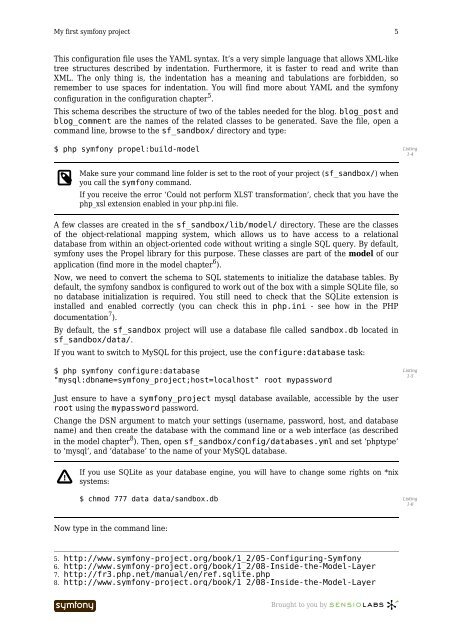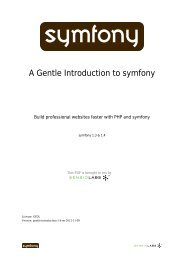My first symfony project - Mesurex
My first symfony project - Mesurex
My first symfony project - Mesurex
- No tags were found...
Create successful ePaper yourself
Turn your PDF publications into a flip-book with our unique Google optimized e-Paper software.
<strong>My</strong> <strong>first</strong> <strong>symfony</strong> <strong>project</strong> 5This configuration file uses the YAML syntax. It’s a very simple language that allows XML-liketree structures described by indentation. Furthermore, it is faster to read and write thanXML. The only thing is, the indentation has a meaning and tabulations are forbidden, soremember to use spaces for indentation. You will find more about YAML and the <strong>symfony</strong>configuration in the configuration chapter 5 .This schema describes the structure of two of the tables needed for the blog. blog_post andblog_comment are the names of the related classes to be generated. Save the file, open acommand line, browse to the sf_sandbox/ directory and type:$ php <strong>symfony</strong> propel:build-modelListing1-4Make sure your command line folder is set to the root of your <strong>project</strong> (sf_sandbox/) whenyou call the <strong>symfony</strong> command.If you receive the error ‘Could not perform XLST transformation’, check that you have thephp_xsl extension enabled in your php.ini file.A few classes are created in the sf_sandbox/lib/model/ directory. These are the classesof the object-relational mapping system, which allows us to have access to a relationaldatabase from within an object-oriented code without writing a single SQL query. By default,<strong>symfony</strong> uses the Propel library for this purpose. These classes are part of the model of ourapplication (find more in the model chapter 6 ).Now, we need to convert the schema to SQL statements to initialize the database tables. Bydefault, the <strong>symfony</strong> sandbox is configured to work out of the box with a simple SQLite file, sono database initialization is required. You still need to check that the SQLite extension isinstalled and enabled correctly (you can check this in php.ini - see how in the PHPdocumentation 7 ).By default, the sf_sandbox <strong>project</strong> will use a database file called sandbox.db located insf_sandbox/data/.If you want to switch to <strong>My</strong>SQL for this <strong>project</strong>, use the configure:database task:$ php <strong>symfony</strong> configure:database"mysql:dbname=<strong>symfony</strong>_<strong>project</strong>;host=localhost" root mypasswordListing1-5Just ensure to have a <strong>symfony</strong>_<strong>project</strong> mysql database available, accessible by the userroot using the mypassword password.Change the DSN argument to match your settings (username, password, host, and databasename) and then create the database with the command line or a web interface (as describedin the model chapter 8 ). Then, open sf_sandbox/config/databases.yml and set ‘phptype’to ‘mysql’, and ‘database’ to the name of your <strong>My</strong>SQL database.If you use SQLite as your database engine, you will have to change some rights on *nixsystems:$ chmod 777 data data/sandbox.dbListing1-6Now type in the command line:5. http://www.<strong>symfony</strong>-<strong>project</strong>.org/book/1_2/05-Configuring-Symfony6. http://www.<strong>symfony</strong>-<strong>project</strong>.org/book/1_2/08-Inside-the-Model-Layer7. http://fr3.php.net/manual/en/ref.sqlite.php8. http://www.<strong>symfony</strong>-<strong>project</strong>.org/book/1_2/08-Inside-the-Model-Layer----------------- Brought to you by















